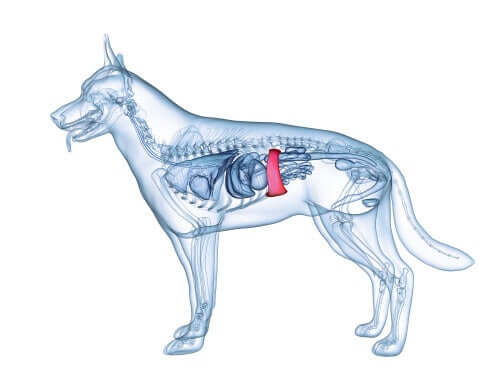What Is an Enlarged Spleen in Dogs?


Written and verified by the biologist Silvia Conde
An enlarged spleen is a worrying diagnosis, as this organ is very important for the defense of a dog’s organism — it’s part of their vertebrate immune system. This organ serves the same function in dogs as it does in humans. This is because it contains lymphocytes, the cells in charge of fighting invading microorganisms.
What’s the spleen for?
Firstly, the spleen is located in the left abdominal wall and is the main source of immune cells next to the lymph nodes, and it also has a blood-filtering action. Thus, it:
- Prevents infections by producing lymphocytes that act against disease-causing microorganisms
- Filters the blood and destroys old damaged cells
- Finally, it stores red blood cells and platelets; these are involved in oxygenation and blood clotting

Enlarged spleen in dogs
Lymphoma and hemangiosarcoma tumors are the most common diseases that afflict the spleen. Also, hemangiosarcoma is the most frequent tumor in dogs. In addition, males have a greater predisposition for spleen problems, together with certain breeds, such as the German Shepherd, Golden Retriever, Labrador Retriever, and Boxer. Generally, it affects older dogs.
Hemangiosarcoma
This is a malignant tumor that has a tendency to invade other body tissues. We don’t know the exact cause yet, and the prognosis isn’t favorable. So, the only treatment is mainly for extending the life of an animal as much as possible while maintaining their well-being.
Hemangiosarcoma can cause blood problems such as lack of coagulation. In addition, the symptoms of this disease aren’t too specific, but the following symptoms usually appear:
- Swelling of the abdomen. The spleen becomes inflamed and enlarges (splenomegaly) by swelling the abdominal cavity.
- Bigger lymph nodes. There are submandibular, prescapular, axillary, inguinal and popliteal nodes in a dog. You can actually feel them with your hands when they swell.
- Anorexia or loss of appetite
- Vomiting. The spleen takes up more space and can exert pressure on the stomach, causing the animal to vomit.
- Lethargy
- Fever
- Weight loss
- Hemorrhage. This is a hypovolemic shock and an emergency situation, so consult your vet immediately.
- Anemia. A vet can detect this by doing a blood test.
- Pale gums
- Diarrhea
- Dehydration
- Cardiac disorders – an increase or decrease in normal heart rate
If the tumor continues to grow, it can break the spleen and lead to an acute collapse in the circulatory system, with difficulty breathing, and this will put the dog’s life at serious risk.

Treatment of enlarged spleen in dogs
Proper diagnosis and treatment depend on the size and location of the tumor. Thus, the symptoms also pertain to the latter. So, you must rule out metastases to other organs through specific veterinary tests, such as x-rays, abdominal ultrasound, and mass analysis or biopsies.
Treatment requires surgery to remove the spleen and the proper medical term is splenectomy. However, this intervention doesn’t cure the disease, although it does help to slow down the process.
Vets use chemotherapy combined with surgery to remit cancer and extend a dog’s life expectancy. Chemotherapy in dogs – and cats – have fewer side effects than in people and can greatly increase their quality of life. The veterinarian prescribes the dosage and frequency of the chemotherapy treatment, but the owner alone decides how long they’d like to extend it.
Generally, chemotherapy after surgery greatly increases survival, so it’s worth continuing this treatment for as long as your veterinarian stipulates it.
Can a dog live without a spleen?
The answer is yes, but as long as it receives immuno-potentiating treatments. Also, you must take care of all aspects of the animal’s health, such as weight, activity, food, and visits to the veterinarian. However, if the problem is due to a malignant tumor, then the removal of the spleen won’t guarantee a cure.
An enlarged spleen is a worrying diagnosis, as this organ is very important for the defense of a dog’s organism — it’s part of their vertebrate immune system. This organ serves the same function in dogs as it does in humans. This is because it contains lymphocytes, the cells in charge of fighting invading microorganisms.
What’s the spleen for?
Firstly, the spleen is located in the left abdominal wall and is the main source of immune cells next to the lymph nodes, and it also has a blood-filtering action. Thus, it:
- Prevents infections by producing lymphocytes that act against disease-causing microorganisms
- Filters the blood and destroys old damaged cells
- Finally, it stores red blood cells and platelets; these are involved in oxygenation and blood clotting

Enlarged spleen in dogs
Lymphoma and hemangiosarcoma tumors are the most common diseases that afflict the spleen. Also, hemangiosarcoma is the most frequent tumor in dogs. In addition, males have a greater predisposition for spleen problems, together with certain breeds, such as the German Shepherd, Golden Retriever, Labrador Retriever, and Boxer. Generally, it affects older dogs.
Hemangiosarcoma
This is a malignant tumor that has a tendency to invade other body tissues. We don’t know the exact cause yet, and the prognosis isn’t favorable. So, the only treatment is mainly for extending the life of an animal as much as possible while maintaining their well-being.
Hemangiosarcoma can cause blood problems such as lack of coagulation. In addition, the symptoms of this disease aren’t too specific, but the following symptoms usually appear:
- Swelling of the abdomen. The spleen becomes inflamed and enlarges (splenomegaly) by swelling the abdominal cavity.
- Bigger lymph nodes. There are submandibular, prescapular, axillary, inguinal and popliteal nodes in a dog. You can actually feel them with your hands when they swell.
- Anorexia or loss of appetite
- Vomiting. The spleen takes up more space and can exert pressure on the stomach, causing the animal to vomit.
- Lethargy
- Fever
- Weight loss
- Hemorrhage. This is a hypovolemic shock and an emergency situation, so consult your vet immediately.
- Anemia. A vet can detect this by doing a blood test.
- Pale gums
- Diarrhea
- Dehydration
- Cardiac disorders – an increase or decrease in normal heart rate
If the tumor continues to grow, it can break the spleen and lead to an acute collapse in the circulatory system, with difficulty breathing, and this will put the dog’s life at serious risk.

Treatment of enlarged spleen in dogs
Proper diagnosis and treatment depend on the size and location of the tumor. Thus, the symptoms also pertain to the latter. So, you must rule out metastases to other organs through specific veterinary tests, such as x-rays, abdominal ultrasound, and mass analysis or biopsies.
Treatment requires surgery to remove the spleen and the proper medical term is splenectomy. However, this intervention doesn’t cure the disease, although it does help to slow down the process.
Vets use chemotherapy combined with surgery to remit cancer and extend a dog’s life expectancy. Chemotherapy in dogs – and cats – have fewer side effects than in people and can greatly increase their quality of life. The veterinarian prescribes the dosage and frequency of the chemotherapy treatment, but the owner alone decides how long they’d like to extend it.
Generally, chemotherapy after surgery greatly increases survival, so it’s worth continuing this treatment for as long as your veterinarian stipulates it.
Can a dog live without a spleen?
The answer is yes, but as long as it receives immuno-potentiating treatments. Also, you must take care of all aspects of the animal’s health, such as weight, activity, food, and visits to the veterinarian. However, if the problem is due to a malignant tumor, then the removal of the spleen won’t guarantee a cure.
All cited sources were thoroughly reviewed by our team to ensure their quality, reliability, currency, and validity. The bibliography of this article was considered reliable and of academic or scientific accuracy.
- Fidalgo, L. E., Rejas, J., Ruiz de Dopegui, R., Ramos, J. J. (2003). Patología Médica Veterinaria. Salamanca, Kadmos.
- Castillo, N. & Portillo, I. (2015). Revisión del hemangiosarcoma canino. Portal Veterinaria. https://www.portalveterinaria.com/animales-de-compania/articulos/24909/revision-del-hemangiosarcoma-canino.html
- Bretón, J. (2020) Revisión monográfica de las patologías presentes en bazo de caninos y felinos diagnosticados por radiografía y ecografía durante un periodo comprendido entre 2012 y 2020. (Tesis de grado, Universidad Cooperativa de Colombia).
- Ochoa, L. N., & Bouda, J. (2007). Patología clínica veterinaria. UNAM, Facultad de Medicina Veterinaria y Zootecnia.
- Finkelstein Hetzel, A. (2012). Enfermedades de resolución quirúrgica y técnicas operatorias del bazo en el perro. (Tesis de grado, Universidad de Chile)
- Parra, M. V. (2011). Shock hemorrágico. Revista Médica Clínica Las Condes, 22(3), 255-264.
This text is provided for informational purposes only and does not replace consultation with a professional. If in doubt, consult your specialist.








